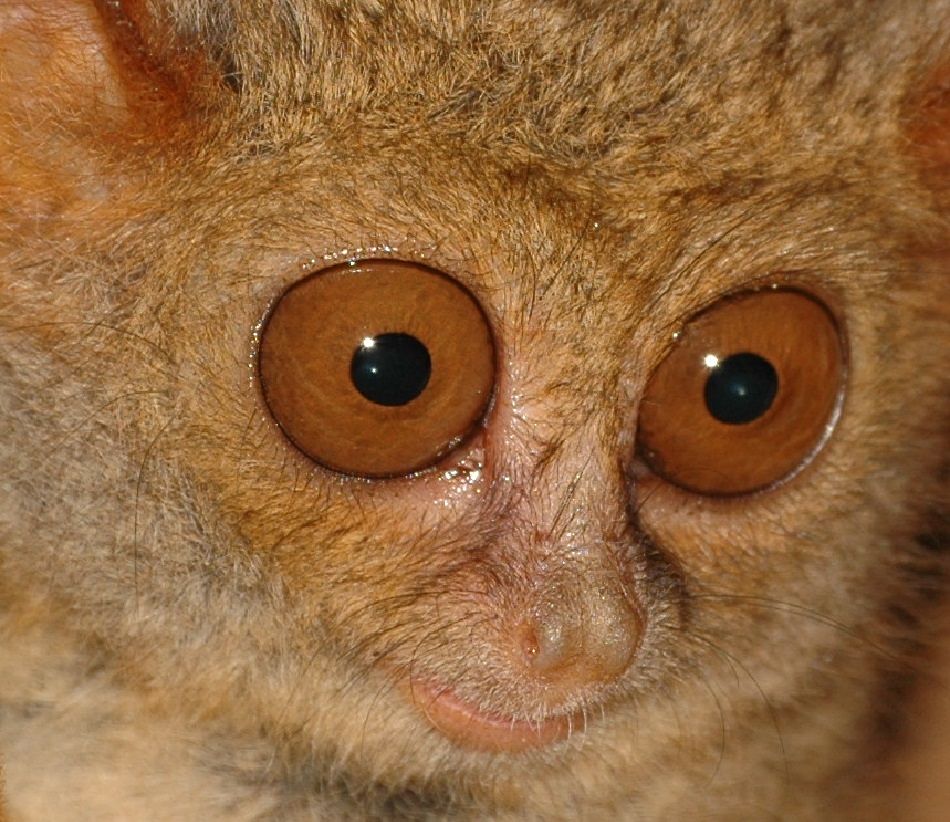tarsier Facts
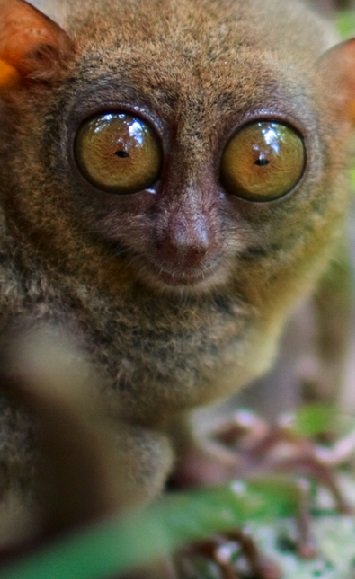 Portrait of a Tarsier
Portrait of a TarsierOne of the particularly cool tarsier facts, is that each one of their enormous eyes actually weighs more than their brain! The tarsier is a tiny primate with a whole bunch of unique characteristics, and a fossil history that dates back 50 million years.
It is a spectacular looking little animal, with enormous eyes, a delicate, elf-like nose and a sweet grin. They have expressive hands and fingers, and freakishly long hind legs folded up under their bellies.
Most of us have only seen them static, frozen in a photo, or a meme, like a fuzzy brown tennis ball, clinging to a reed. The coiled position they are most often photographed in, makes them look round, maybe even a little plump, however the tarsier is actually a slender, lean athlete, with the longest legs relative to total body size of any animal on Earth.
The tarsier is one of the smallest primates, most certainly one of the oldest, and also the only primate that is completely carnivorous. They spend the night hunting for insects, and the occasional reptile or tiny bird, and journey through the forest by springing from tree to tree, using their incredible legs to jump up to 15 feet in one shot, or practically 30 times their body length.
The tarsiers body proportions are similar to that of a kangaroo, with shorter front limbs and stretched out hind legs, but in the kangaroo it is mostly the shin - the tibia and the fibula bones - that are elongated. In the tarsier it is the calcaneum and navicular bones of the ankle, also known as the tarsal bones, that are freakishly long, and this is actually where the name tarsier comes from.
On the ground, the tarsier hops like a frog, but can also move with a quadrupedal walk. They are usually on the ground for just a few moments while they trap and eat an insect or two, then return to the trees.
The hands and feet have tiny, rounded tips, like suction cups. The thumb is not opposable, but the big toe is, and the hind foot is able to rotate drastically to allow grasping of branches in a variety of positions. There are flattened nails on all fingers and toes except the third and fourth toes, which have long, curved claws designed specifically for grooming.
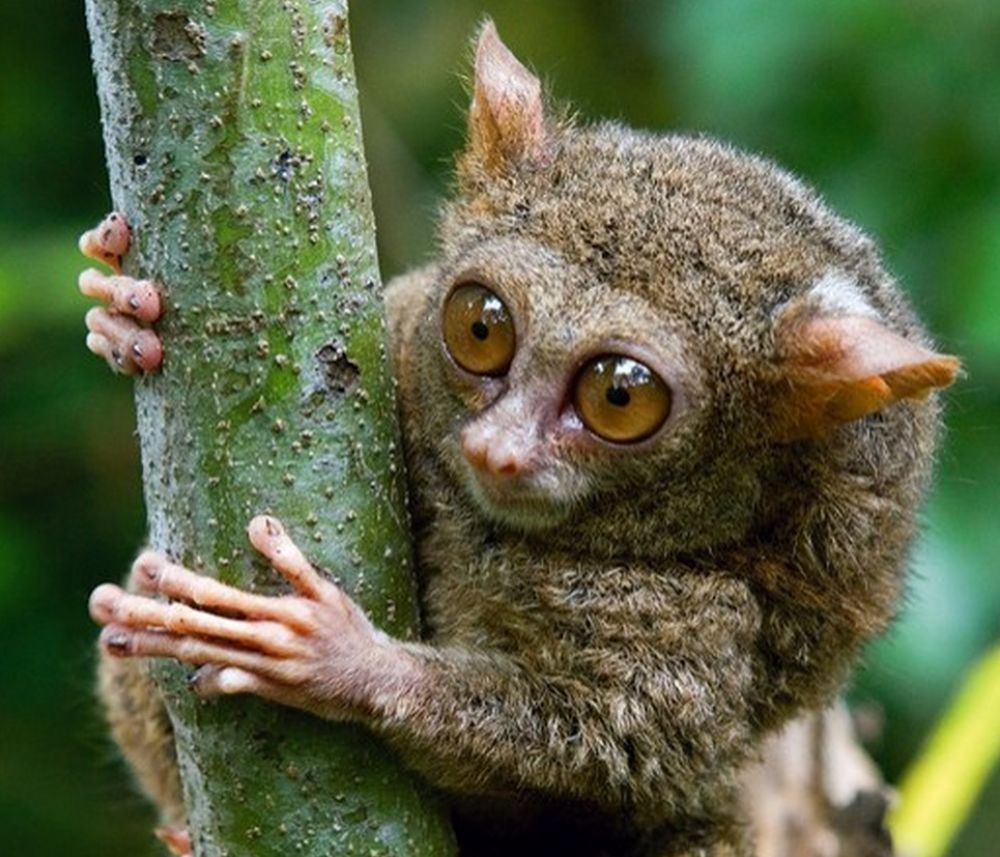
Tarsiers also have a long, mostly naked tail, often with a little tuft of hair on the end, that actually has dermal ridges like a fingerprint on the underside, to provide traction against smooth surfaces. The tail is not prehensile, but acts as a rudder in the air, and like a tripod at rest, allowing the tarsier to sit comfortably on vertical branches.
At one time they could be found in many corners of the world, including Europe and North America, but now they live in rainforests throughout Borneo, Indonesia, and the Philippines.
Tarsiers spend most of their time clinging to vertical reeds and branches. The enormous eyes of the tarsier are the largest in proportion to body size of any mammal. The visual cortex, which is the area of the brain devoted to vision, is correspondingly huge.
The eyeballs can't move within the eyes sockets, but the neck is designed to allow the head to rotate 180 degrees in either direction, giving them a 360 degree field of vision, just like an owl. No other mammal can swivel their head as far. The eyes lack the reflective quality of many nocturnal animals, which is probably why they need to be so large, and suggests that the tarsiers ancestors were probably active during the daylight.
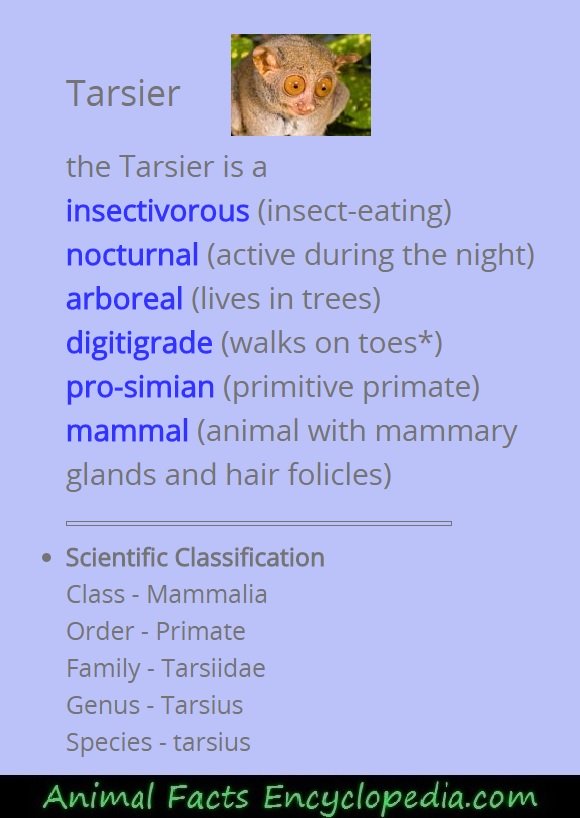
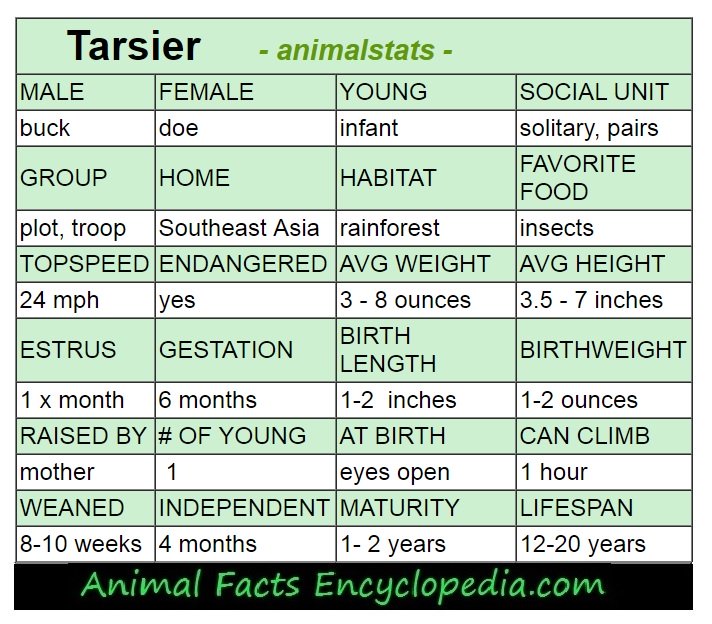
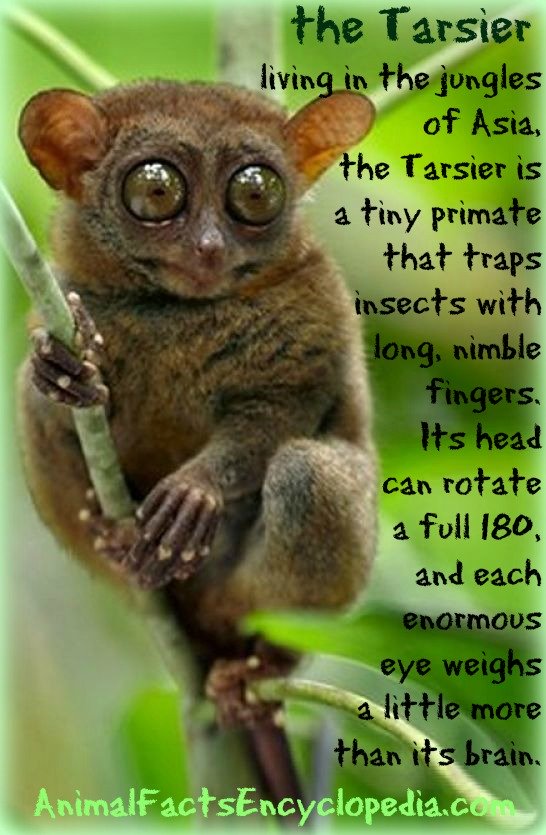
What is a tarsier?
There is lots of confusion and discussion about where to place tarsiers on the primate family tree.. The question is whether they are prosimians, which is how they were originally classified, or apes. Although they look allot like the prosimian lemurs, lorises and bush babys, and have some similar traits like grooming claws and a nocturnal lifestyle, they actually have many more features of apes.
Just like apes, tarsiers lack a rhinarium, which is the exposed, wet surface around the nostrils found in most mammals, (think of a dog nose), and they don't have the reflective layer in the eye called the tapetum lucidum, that makes many animals eyes glow in the dark. There are aspects of skull structure and dentition that also point to them being more like apes. So in recent years, they have been classified in their own infraorder, with their own family, between these two branches of primates, and are not considered monkeys.
But the tarsier has been around for millions more years than any of these other primates and shows no evolutionary link to them. In facts, the tarsier just seemed to spring out of the Miocene age without any clear connection to any other creatures.
The first fossil record of the tarsier, is a 50 million year old tarsier, and other than growing a bit smaller, they simply haven't changed that much. This has led many to point to the tarsier as an example of creationism, since science can't even begin to offer an explanation not just of who they are related to, but where they came from in the first place.
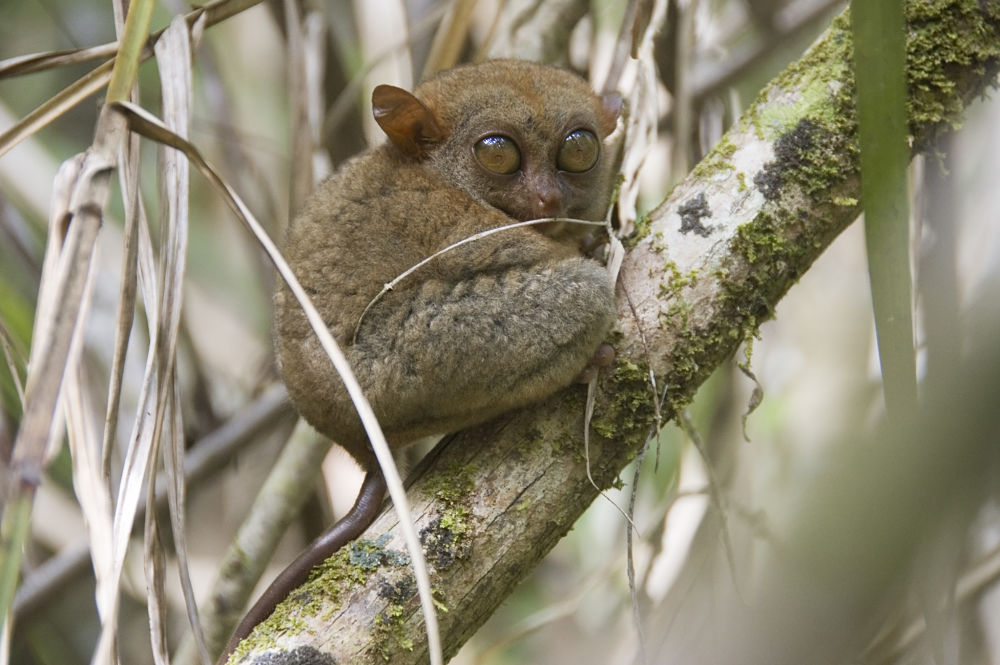 tarsier in the reeds
tarsier in the reedstarsier lifestyle
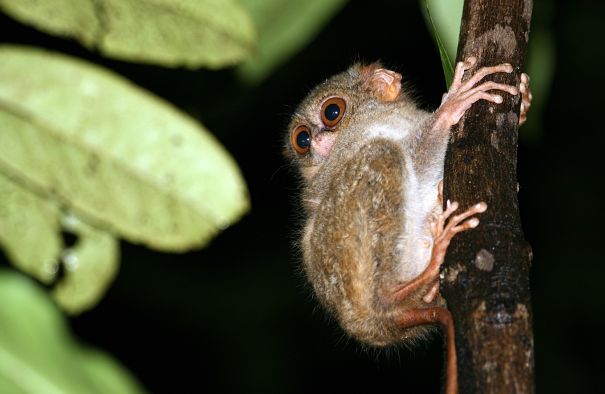
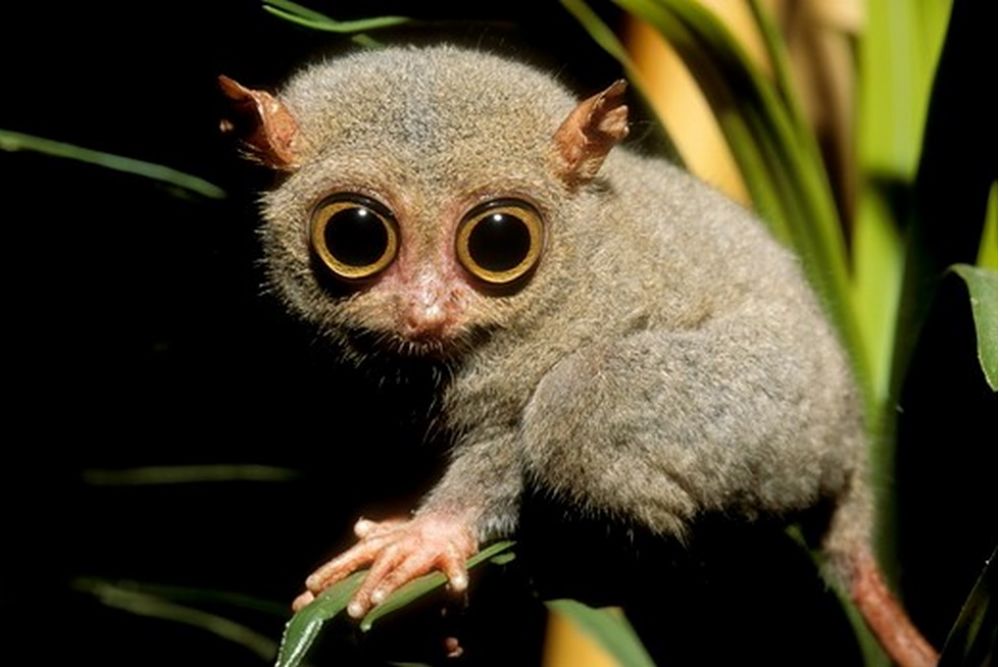 tarsier with pupils dilated in the dark - taken with quick flash
tarsier with pupils dilated in the dark - taken with quick flashThe tarsier is an extremely mysterious little animal that not much is known about.
Even how many species there are is unknown, since the investigation it takes to identify differences is just not taking place, and the information that is available is greatly disputed.
Currently, there are considered to be anywhere between 6 and 26 different species depending on the source. The species vary only slightly in lifestyle, vocalizations, eye and ear size, and they also have different lengths and amounts of hair on their tails.
The vocalizations have come to be a reasonable source in identifying different species. Once thought to be a very quiet animal, there have been recent insights into their communication habits.
The tarsier is one of the few animals that is considered to "sing", meaning they repeat melodic notes in sequence, like birds. But it's only recently been discovered that tarsiers make ultrasonic noises - sounds that are so high in frequency that the human ear can't hear them.
This discovery is a bit embarrassing for researchers, because tarsiers often open their mouths in large gapes that looked like silent screams. Long explained away as yawns by scientists, they actually are screams, usually warning calls, that we just can't hear.
Like a tree falling in a forest, observers believed their own sensory experience was the only one that counted. After it was discovered several years ago that elephants communicate in sounds too low for us to hear, now some specific investigation is long overdue into the possible communications going on of animal species that are above or below our own audio abilities.
Tarsiers sleep during the day, clinging to a vertical tree branch or vine. They don't build nests, but some species, like the spectral tarsier, like to sleep in hollow trees. They wake at sunset and set out swiftly across their territory to hunt a variety of insects including grasshoppers and beetles. They mark the perimeters of their territories with urine, and will defend it from other groups, although territories do overlap.
The tarsier uses its excellent vision and keen hearing to hunt. The ears are constantly twitching and rotating to catch sounds of possible prey, and its head swivels to locate it. The tarsier will open its eyes as wide as possible to focus on a target up in the trees or on the jungle floor. Most photos of tarsiers are taken in daylight, so the pupils are tiny, and the gold/green eye color is prominant, but in the dark of night the pupil is huge and nearly fills the eye.
Once dinner is spotted the tarsier may adjust its body position, or move a step closer, measuring the distance, then pounces on its prey, trapping it with its hands and holding it up to its mouth to consume. They have very sharp teeth, and the mouth is very large, spanning across the width of the face.
Speaking of the face, tarsiers have very expressive ones. Their upper lips have musculature similar to our own, and the tarseier is capable of making all kinds of human expressions, including grinning from ear to ear. The face doesn't really have a muzzle either, just a small, upturned nose, book-ended by those gigantic eyes - spectacular!
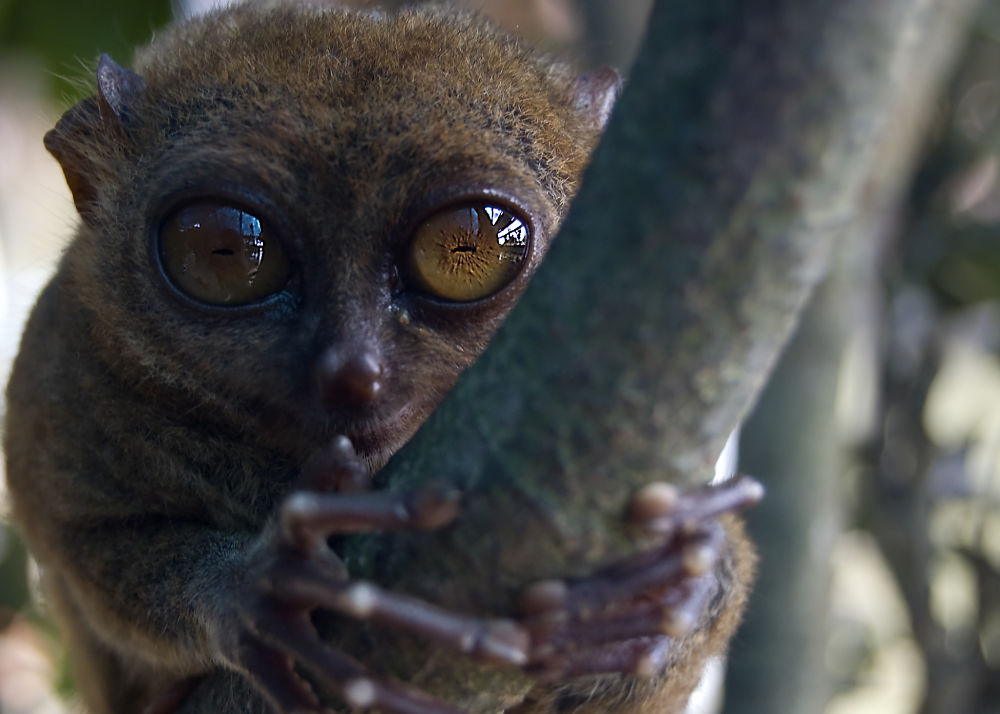 Philippine Tarsier
Philippine Tarsiertarsier facts on reproduction
Tarsier species have different breeding habits, but generally the female comes into estrus once a month. Many of these animals appear to be monogamous, mating for life and living in little groups that include a few offspring. Some species seem to be more solitary, getting together at some point during the day, but otherwise eating and sleeping alone.
The female is pregnant for about 6 months and gives birth to a single infant that is about 1/3 her size. That's about the same as a woman who weighs 120 pounds, giving birth to a 40 pound infant! The baby is born eyes open and furred, but takes a few days to gain mobility. Tarsier mothers "park" their babies on a tree limb, since they are too large to carry around, and hunt a few feet away. In some species, males play a minor role, keeping closer when there is an infant present, and providing some defense from predators.
Tarsiers have been observed to "mob" predators such as snakes, with up to 10 individuals coming together for coordinated attacks, leaping towards and striking at the intruder. A males prowess during these displays may make him more desirable to mate with.
Tarsier babies wean quickly, and by 4 to 6 weeks they are hunting for themselves. Young may stay with the family group for 2 years or more before leaving. Some species form monogamous pairs, some form groups with one male and a few females.
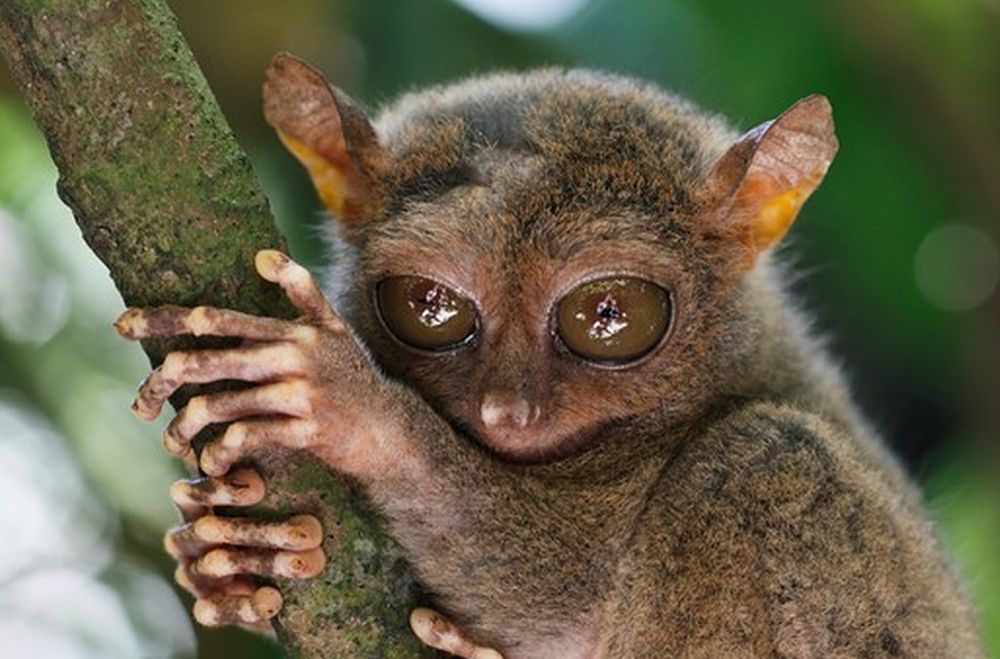

a few more tarsier facts
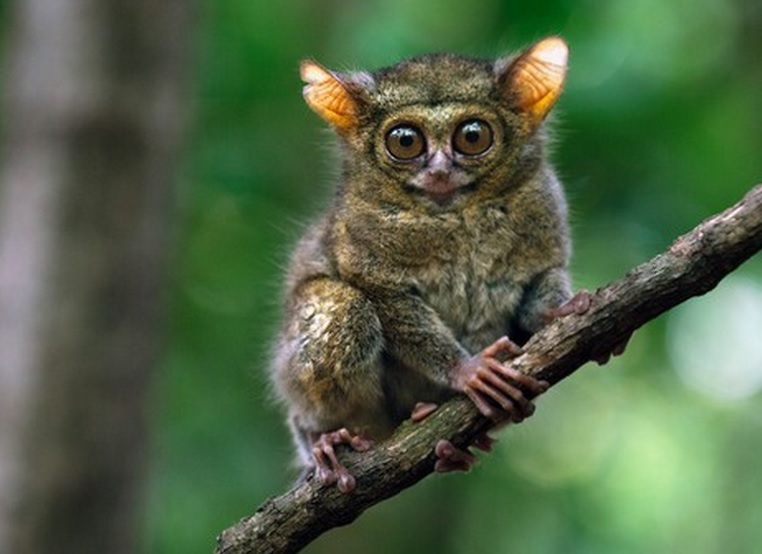
- The tarsiers eyes are bigger than their brain, and their stomach
- Tarsiers can move their heads 180 degrees in either direction
- The ankle bones, or tarsals, of the tarsier are incredibly long
- The tarsier is named for its unique tarsal bones
- The hind legs of the tarsier are longer percentage-wise than any other mammal
- Tarsiers can jump about 30 times their body length
- US Navy Squadron-VF 33 from NAS Oceana Va.-has the Tarsier as its' squadron mascot and insignia
- Tarsier fossils are 50 million years old
- The tarsier makes noises so high in frequency that we can't hear them
Scientific Classification:
| Tarsier - animalstats - | |||
|---|---|---|---|
| MALE | FEMALE | YOUNG | SOCIAL UNIT |
| buck | doe | infant | solitary, pairs |
| GROUP | HOME | HABITAT | FAVORITE FOOD |
| plot, troop | Southeast Asia | rainforest | insects |
| TOPSPEED | ENDANGERED | AVG WEIGHT | AVG HEIGHT |
| 24 mph | yes | 3 - 8 ounces | 3.5 - 7 inches |
| ESTRUS | GESTATION | BIRTH LENGTH | BIRTHWEIGHT |
| 1 x month | 6 months | 1-2 inches | 1-2 ounces |
| RAISED BY | # OF YOUNG | AT BIRTH | CAN CLIMB |
| mother | 1 | eyes open | 1 hour |
| WEANED | INDEPENDENT | MATURITY | LIFESPAN |
| 8-10 weeks | 4 months | 1- 2 years | 12-20 years |
see more animal extreme closeups
Recent Articles
-
African Animals - Animal Facts Encyclopedia
Oct 11, 16 10:27 PM
African Animals facts photos and videos..Africa is a wonderland for animal lovers, and a schoolroom for anyone who wants to learn about nature, beauty and the rhythm of life -
Baboon Facts - Animal Facts Encyclopedia
Oct 11, 16 10:26 PM
Baboon facts, photos, videos and information - Baboons are very distinctive looking monkeys with long, dog-like snouts and close set eyes. -
Great Apes Facts - Animal Facts Encyclopedia
Oct 11, 16 10:25 PM
Great apes facts, photos and videos..Human beings did not evolve from chimpanzees, modern chimps and gorillas do not appear in the fossil records until much more recently than homo sapiens..




















